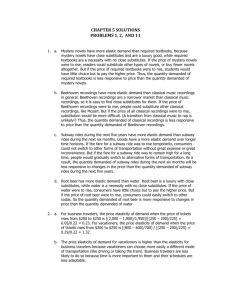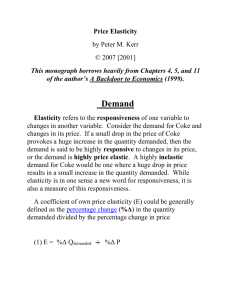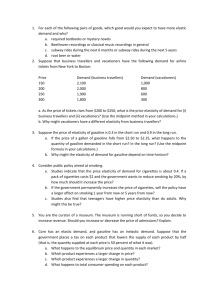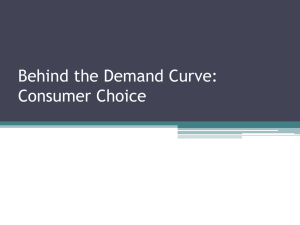Elasticity Problems
advertisement
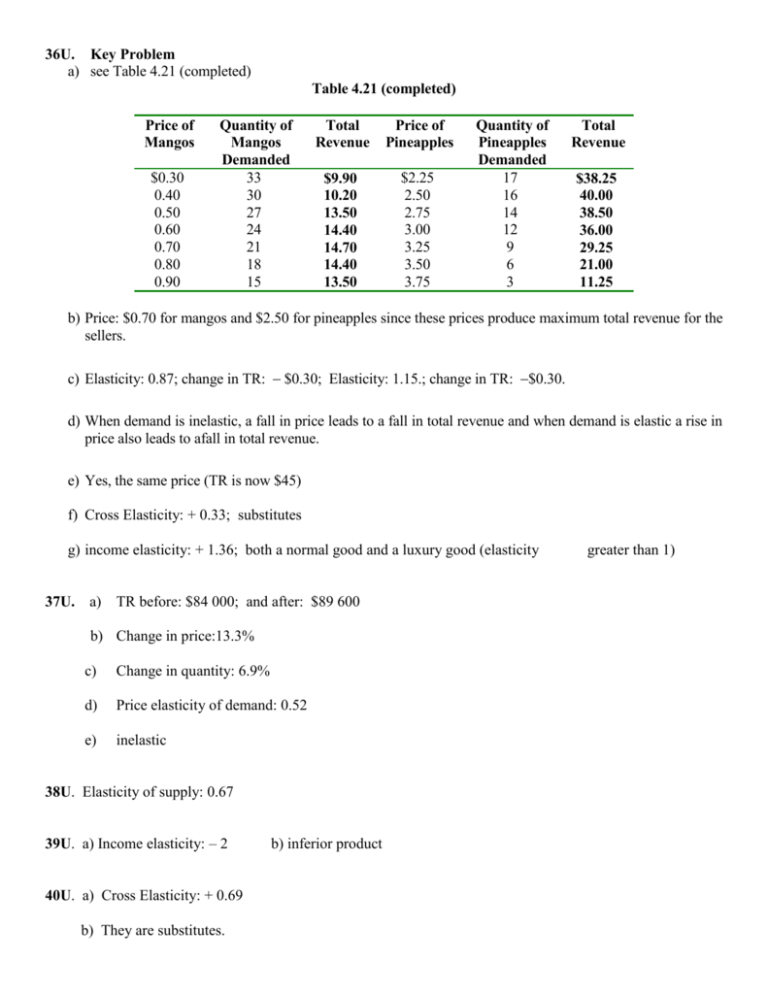
36U. Key Problem a) see Table 4.21 (completed) Table 4.21 (completed) Price of Mangos $0.30 0.40 0.50 0.60 0.70 0.80 0.90 Quantity of Mangos Demanded 33 30 27 24 21 18 15 Total Revenue Price of Pineapples $9.90 10.20 13.50 14.40 14.70 14.40 13.50 $2.25 2.50 2.75 3.00 3.25 3.50 3.75 Quantity of Pineapples Demanded 17 16 14 12 9 6 3 Total Revenue $38.25 40.00 38.50 36.00 29.25 21.00 11.25 b) Price: $0.70 for mangos and $2.50 for pineapples since these prices produce maximum total revenue for the sellers. c) Elasticity: 0.87; change in TR: $0.30; Elasticity: 1.15.; change in TR: $0.30. d) When demand is inelastic, a fall in price leads to a fall in total revenue and when demand is elastic a rise in price also leads to afall in total revenue. e) Yes, the same price (TR is now $45) f) Cross Elasticity: + 0.33; substitutes g) income elasticity: + 1.36; both a normal good and a luxury good (elasticity 37U. a) TR before: $84 000; and after: $89 600 b) Change in price:13.3% c) Change in quantity: 6.9% d) Price elasticity of demand: 0.52 e) inelastic 38U. Elasticity of supply: 0.67 39U. a) Income elasticity: – 2 40U. a) Cross Elasticity: + 0.69 b) They are substitutes. b) inferior product greater than 1) 43U. Income elasticity refers to the responsiveness of quantity demanded to a change in income. If the coefficient is positive it means that the product is a normal one; further if it has a value greater than 1, then it is also a luxury product. 48U. Price elasticity: 0.68 53U. The sellers will pay all of an excise tax if the demand is perfectly elastic (or the supply is perfectly inelastic.) Answers to “Review Problems” 1. Novels have more elastic demand than required textbooks, because novels have close substitutes and are a luxury good, while required textbooks are a necessity with no close substitutes. If the price of novels were to rise, readers could substitute other types of novels, or buy fewer novels. But if the price of required textbooks were to rise, students would have little choice but to pay the higher price. Thus, the quantity demanded of required textbooks is less responsive to price than the quantity demanded of novels. b. Orange Juice has more elastic demand than juice in general. Orange juice is a narrower market than juice in general, so it is easier to find a close substitute for it. If the price of Orange Juice were to rise, people could substitute drinks, like apple juice. But if the price of all Juice were to rise, substitution would be more difficult. Thus, the quantity demanded of juice in general is less responsive to price than the quantity demanded of Orange Juice. c. Heating oil during the next five years has more elastic demand than heating oil during the next six months. Goods have a more elastic demand over longer time horizons. If the price of heating oil were to rise temporarily, consumers could not switch to other forms of heating without replacing their boiler, which involves significant expense and inconvenience. But if the price of heating oil were to remain high for a long time, people would gradually switch to alternative forms of heating as the natural life of their existing boiler comes to an end. As a result, the quantity demanded of heating oil during the next six months will be less responsive to changes in the price than the quantity demanded during the next five years. d. Lemonade has more elastic demand than water. Lemonade is a luxury with close substitutes, while water is a necessity with no close substitutes. If the price of water were to rise, consumers have little choice but to pay the higher price. But if the price of lemonade were to rise, consumers could easily switch to other soft drinks. So the quantity demanded of lemonade is more responsive to changes in price than the quantity demanded of water. 2. i. PED= %ΔQd / %ΔP %ΔP = [ (150-100) / 125 ] x 100% = 40% %ΔQd = [ (1800-1900) / 1850 ] x 100% = -5.4% Therefore: PED = 5.4/40 = 0.135 ii. %ΔP = [ (150-100) / 125 ] x 100% = 40% %ΔQd = [ (600-800) / 700 ] x 100% = -28.6% Therefore: PED = 28.6/40 = 0.714 b. The price elasticity of demand for holiday travelers is higher than the elasticity for business travelers because holiday travelers can more easily choose a different mode of transportation (like driving or taking the train) or a different destination. Business travelers are less likely to do so because time is more important to them and their schedules are less adaptable. 3. Price elasticity of demand is equal to the ratio of the percentage change in quantity demanded to the percentage change in price: PED = %ΔQd / %ΔP The slope of the demand curve, on the other hand, is simply equal to the ratio of the change in quantity demanded to the change in price: Slope = ΔQd/ΔP Along a straight-line demand curve, the slope is constant. However, as you go down the straight-line demand curve, price falls and quantity increases. In other words, as you go down the straight-line demand curve, the first term in equation (1) is constant, but the second term decreases. Hence, the PED decreases. 4. a. Substitutes - an increase in the price of one good causes an increase in demand for the other b. Demand will increase by 5% x 1.2 = 6% [%ΔQdA = CrossPriceED x %ΔPB] 5. For given fluctuations in supply prices fluctuate much more in markets with inelastic demand than in those with elastic demand. Therefore, if the demand for fuel is less elastic than the demand for cars, then this would explain some of the extra volatility in fuel prices.




